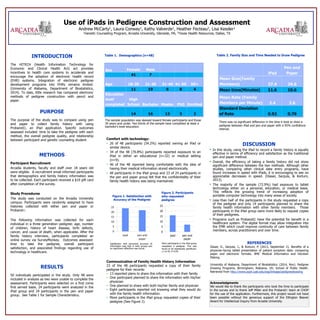
2015 NSGC poster Andrew McCarty 3
- 1. Use of iPads in Pedigree Construction and Assessment Andrew McCarty1, Laura Conway1, Kathy Valverde1, Heather Fecteau2, Lisa Kessler1 1Genetic Counseling Program, Arcadia University, Glenside, PA; 2Texas Health Resources, Dallas, TX INTRODUCTION The HITECH (Health Information Technology for Economic and Clinical Health Act) act provides incentives to health care systems to accelerate and encourage the adoption of electronic health record (EHR) systems. Integration of electronic pedigree development programs into EHRs remains limited. (University of Alabama, Department of Biostatistics, 2014). To date, little research has compared electronic methods of pedigree construction with pencil and paper. PURPOSE The purpose of the study was to compare using pen and paper to collect family history with using Proband©, an iPad application. Specific outcomes assessed included: time to take the pedigree with each method, the overall pedigree quality, and relationship between participant and genetic counseling student METHODS Participant Recruitment Arcadia students, faculty and staff over 18 years old were eligible. A recruitment email informed participants that demographics and family history information was to be collected. Each participant received a $10 gift card after completion of the survey. Study Procedures The study was conducted on the Arcadia University campus. Participants were randomly assigned to have histories collected with either pen and paper or Proband©. The following information was collected for each individual in a three generation pedigree: age, number of children, history of heart disease, birth defects, cancer, and cause of death, when applicable. After the family history interview, participants completed an online survey via SurveyMonkey. Outcomes assessed: time to take the pedigree, overall participant satisfaction, and associated findings regarding use of technology in healthcare. RESULTS 50 individuals participated in the study. Only 48 were included in analysis as two were unable to complete the assessment. Participants were selected on a first come first served basis. 24 participants were analyzed in the iPad group and 24 participants in the pen and paper group. See Table 1 for Sample Characteristics. DISCUSSION • In this study, using the iPad to record a family history is equally effective in terms of efficiency and satisfaction as the traditional pen and paper method. • Overall, the efficiency of taking a family history did not show significant difference between the two methods. Although other studies, comparing other clinical data entry programs, have found increases in speed with iPads, it is encouraging to see no appreciable decreases in speed. (Glaser, Sanjula, & Kortum, 2013). • The majority of the sample (72.9%) had exposure to tablet technology either on a personal, education, or medical basis. This reflects the growing trend of increasing adoption of portable computer technology into many areas of society. • Less than half of the participants in the study requested a copy of the pedigree and only 14 participants planned to share the family health information with other family members. Those participants in the iPad group were more likely to request copies of their pedigrees. • Programs such as Proband© have the potential for benefit in a healthcare system. The digital format may allow integration into the EMR which could improve continuity of care between family members, across practitioners and over time. Figure 1. Satisfaction Between Groups Table 1. Demographics (n=48) Comfort with technology: • 26 of 48 participants (54.2%) reported owning an iPad or similar device. • 34 of the 48 (70.8%) participants reported exposure to an iPad in either an educational (n=32) or medical setting (n=9). • 46 of the 48 reported being comfortable with the idea of having their medical information stored electronically. • All participants in the iPad group and 23 of 24 participants in the pen and paper group felt that the confidentiality of their family health history was being maintained. There was no significant difference in the time it took to draw a pedigree between iPad and pen and paper with a 95% confidence interval. Acknowledgments We would like to thank the participants who took the time to participate in the survey and to thank Jeff Miller and the Proband© team at CHOP for the use of the application. Furthermore, this project would not have been possible without the generous support of the Ellington Beaver Award for Intellectual Inquiry from Arcadia University. The sample population was skewed toward female participants and those 30 years and under. Two thirds of the sample have completed at least a bachelor’s level education. Overall Satisfaction Figure 1. Satisfaction with Accuracy of the Pedigree REFERENCES Glaser, D., Sanjula, J., & Kortum, P. (2013, September 2). Benefits of a physician-facing tablet presentation of patient symptom data: comparing paper and electronic formats. BMC Medical Informatics and Decision Making. University of Alabama, Department of Biostatistics. (2014, Nov). Pedigree Drawing Programs. Birmingham, Alabama, US: School of Public Health. Retrieved from http://www.soph.uab.edu/ssg/linkage/pedigreedrawing 0 5 10 15 20 25 ipad pen and paper Satisfaction with perceived accuracy of information was high in both groups and no significant difference was found. Table 2. Family Size and Time Needed to Draw Pedigree Communication of Family Health History Information 23 of the 48 participants requested a copy of their family pedigree for their records: • 13 reported plans to share this information with their family • One participant planned to share the information with his/her physician • One planned to share with both his/her family and physician • Eight participants reported not knowing what they would do with the family health information. • More participants in the iPad group requested copies of their pedigree (See Figure 2) 0 5 10 15 20 25 ipad pen and paper Figure 2. Participants who requested pedigree More participants in the iPad group requested a pedigree. This was found to be statistically significant. c2=6.76, P<0.05